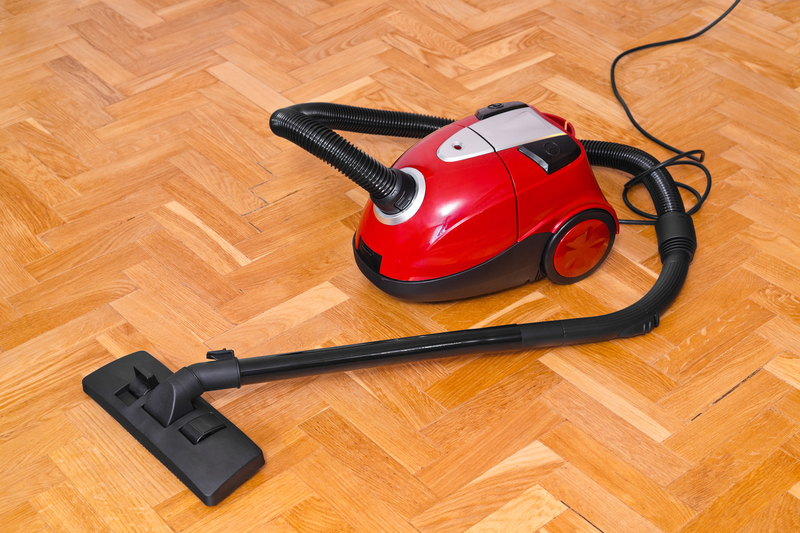Transform Velvet Curtain Cleaning into a Safe Routine
Posted on 02/10/2025
Transform Velvet Curtain Cleaning into a Safe Routine
Velvet curtains add a touch of elegance and sophistication to any room. Their luxurious texture and striking appearance make them a popular choice among homeowners and interior designers alike. However, despite their undeniable charm, velvet drapes require meticulous care and regular maintenance to preserve their beauty and longevity. In this comprehensive article, we'll reveal how to safely turn velvet curtain cleaning into a hassle-free, efficient routine that extends the life of your curtains and protects your investment.

Understanding Velvet: Types and Care Essentials
Before delving into the best practices for cleaning velvet curtains at home, it's crucial to recognize the unique qualities of this luxurious fabric. Velvet is distinguished by its dense pile and soft, plush texture, characteristics that make it both attractive and prone to collecting dust, pet hair, and even spills.
Common Types of Velvet Used in Curtains
- Crushed Velvet - Recognized by its intentionally wrinkled texture, crushed velvet is durable yet requires special care to maintain its finish.
- Cotton Velvet - Natural and soft, this type of velvet is more breathable but may shrink if improperly cleaned.
- Synthetic Velvet - Made from polyester or nylon, this variant is often more resistant to stains and slightly easier to clean.
- Silk Velvet - The most luxurious but delicate, requiring utmost caution during any cleaning routine.
Understanding your curtain's fabric composition is the first step toward a safe velvet curtain cleaning routine.
Why Routine Velvet Curtain Cleaning Matters
- Preserves Appearance: Routine cleaning helps maintain the rich color and soft texture velvet is known for.
- Extends Fabric Life: Removing dust, dirt, and allergens reduces fabric degradation.
- Improves Indoor Air Quality: Curtains trap airborne particles; regular cleaning keeps your environment healthier.
Neglecting velvet curtain care can lead to discoloration, matting, and even permanent staining. By establishing a regular and safe velvet curtain cleaning process, you protect your curtains and ensure they remain a stunning focal point in your home.
How to Safely Clean Velvet Curtains: Step-by-Step Guide
Let's break down velvet curtain maintenance into a manageable, safe, and repeatable routine:
1. Read the Care Label
Always start by checking the manufacturer's care label. Some velvet fabrics are best cared for through professional dry cleaning, while others may be safe for gentle hand washing. Ignoring the label's instructions risks unintentional damage.
2. Regular Dusting and Vacuuming
- Use a soft-bristled brush attachment on your vacuum cleaner.
- Gently vacuum velvet drapes from top to bottom, ensuring you don't crush the pile.
- Tip: Hold the fabric taut with one hand while vacuuming to prevent pull.
Dusting and vacuuming weekly minimizes dirt buildup and makes deeper cleaning less frequent and easier.
3. Spot Cleaning Velvet Curtains
- Blot, Don't Rub: In case of spills, gently blot with a clean, absorbent cloth. Rubbing can damage the pile and embed the stain.
- Mild Detergent Solution: Mix a small amount of gentle detergent in cold water. Dampen a soft cloth, wring out excess moisture, and blot the stained area.
- Dry Quickly: Use a fan or hairdryer on the cool setting to dry the fabric and prevent water spots.
Note: Always test cleaning solutions on a hidden area before treating visible parts of your velvet curtain.
4. Hand Washing Velvet Curtains (If Permitted)
Some cotton and synthetic velvets tolerate delicate hand washing:
- Fill a bathtub or basin with cold water and a small amount of mild liquid detergent.
- Gently submerge the curtain, swishing it lightly--never wringing or twisting.
- Rinse thoroughly with cold water to remove all soap residue.
- Press the curtain gently between towels to absorb excess water.
- Hang to air dry, ensuring even support to prevent stretching.
Silk velvet and antique velvet curtains should never be washed with water. These types require professional cleaning only.
5. Steam Cleaning Velvet Curtains
- Use a garment or handheld steamer to refresh velvet drapes safely.
- Hold the steamer several inches away from the fabric.
- Steam from top to bottom, allowing the steam to penetrate and relax wrinkles.
- Once finished, use a soft brush or a velvet brush to restore the pile.
Steam cleaning not only removes wrinkles and freshens the curtain, but also kills dust mites and bacteria, making velvet curtain sanitizing effective without harsh chemicals.
Velvet Curtain Cleaning Safety Tips
- Never saturate velvet:** Avoid soaking, as too much water damages the pile and may lead to shrinkage or color bleeding.
- Test all products first: Even mild detergents can cause unexpected reactions. Always spot test in an inconspicuous area.
- Use cold water only: Hot water increases the risk of warping and discoloration.
- Keep sunlight exposure minimal while drying: Direct sun can fade and weaken velvet fabric. Dry curtains in a shaded, well-ventilated area.
- Do not iron directly: Direct heat crushes the nap. If necessary, steam lightly or use a velvet board and minimal heat.
Professional Velvet Curtain Cleaning
For expensive, antique, or especially delicate velvet drapes, professional curtain cleaning is the safest choice. Reputable cleaners use specialized equipment and solvents designed for velvet and can also help with:
- Stain removal
- Restoring the original sheen and texture
- Eliminating deep-seated odors and allergens
Tip: Opt for curtain cleaning professionals with specific experience in velvet fabrics to ensure the best results.
Establishing a Routine: A Yearly Velvet Curtain Cleaning Calendar
Turning velvet curtain care into a routine guarantees consistently gorgeous drapes. Here's an optimal cleaning schedule:
- Weekly: Gently vacuum or brush curtains to remove surface dust and allergens.
- Monthly: Spot clean or lightly steam any visible marks or wrinkles as needed.
- Every 6 months: Deep clean curtains at home, if labeled safe, or take them to professional cleaners.
- Annually: Inspect curtain hardware and lining. Wash window frames and check for any signs of mold or mildew behind the fabric.
Building consistent habits helps you spot problems early, address stains promptly, and keep your velvet drapes looking brand new year after year.
Addressing Common Velvet Curtain Cleaning Questions
Can you machine wash velvet curtains?
Most velvet curtains are not recommended for machine washing, as the agitator and spin cycle can crush and distort the nap. Only certain synthetic velvets with clear manufacturer approval may be washed by machine--and always on the gentlest cycle with cold water.
What if curtains have odor but no visible stains?
Use a garment steamer combined with a light mist of fabric-safe deodorizer. Ensure the room is well-ventilated for drying. Alternatively, hang the curtains outdoors in indirect sunlight for a few hours for a natural refresh.
How do you store velvet curtains?
- Clean before storing to prevent dirt setting into the pile.
- Roll, don't fold, to avoid deep creases and flattening the fabric.
- Wrap rolls in acid-free tissue paper and keep in a cool, dry, dark place.
Natural and Eco-Friendly Solutions for Velvet Curtain Cleaning
For those who prefer chemical-free options, you can opt for:
- Baking Soda: Sprinkle a light layer over seats of persistent odor, let sit for 15 minutes, then vacuum with a soft brush.
- White Vinegar: Mix a mild solution with water (1:10 ratio), dampen a cloth, and carefully blot stains. Always spot test.
- Organic Soap: Plant-based soaps can be diluted for mild stain removal.
Eco-friendly approaches are not only safe for velvet drapery cleaning, but also protect your indoor air and the environment.
The Do's and Don'ts of Velvet Curtain Cleaning
Do's
- Regularly remove dust and pet hair.
- Use cool water and gentle products.
- Air dry velvet curtains whenever possible.
- Brush pile gently to rejuvenate its natural texture.
- Act quickly on spills.
Don'ts
- Never use harsh chemicals or bleach.
- Do not soak or leave velvet curtains wet for extended periods.
- Never apply direct heat or iron the fabric surface.
- Don't stretch or twist velvet when handling.
- Avoid putting velvet curtains in a tumble dryer.

Velvet Curtain Cleaning Myths Debunked
- Myth: Velvet is too delicate for any kind of home cleaning.
- Truth: With proper methods and attention to fabric type, safe velvet curtain cleaning at home is possible and effective.
- Myth: Vacuuming will ruin velvet.
- Truth: Using a soft brush attachment and gentle motions actually helps preserve the nap and keeps curtains cleaner longer.
- Myth: Only dry cleaning is suitable for velvet.
- Truth: Many modern velvets, especially synthetics, can be spot cleaned or hand washed when instructions permit.
Conclusion: Elevate Your Home with Safe, Consistent Velvet Curtain Maintenance
By transforming velvet curtain cleaning into a safe and systematic routine, you protect both the value and aesthetic of your precious drapes. From regular vacuuming and careful spot treatment to professional cleaning and smart storage, every step counts toward ensuring your velvet remains rich, vibrant, and inviting.
Adopt these velvet curtain cleaning tips into your household schedule for drapes that always look their absolute best--luxurious, clean, and long-lasting.
Remember, the right care not only maintains your velvet curtains' appeal but also contributes to a healthier and more stunning home environment. Make velvet curtain cleaning a safe routine--and let elegance shine through, year after year.




